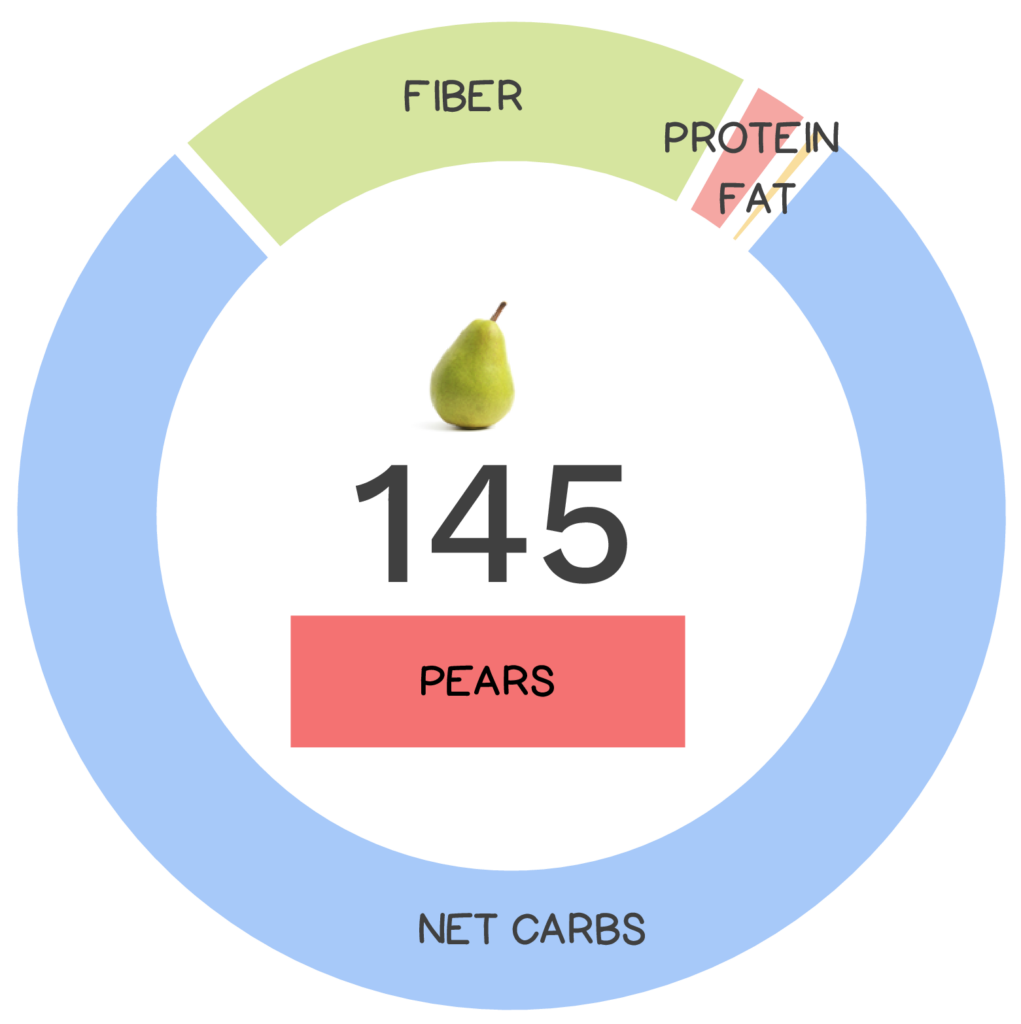
With its distinctive shape, the pear is a sweet, juicy fruit, which brings joy to all who “pear-take” in it! (Hyuck) Not only are pear trees grown for their delicious fruit, but also ornamentally for their beautiful blossoms which are associated with purity, hope, longevity and lasting friendship – and are among the first to bloom each year, welcoming in spring.
Pears are related to apples and roses!
All pears belong to the genus Pyrus in the sub-family Pomoideae within the plant family Rosaceae (AKA the rose family – that’s right, pears are related to roses!) Pears, like apples, are classified as “pomes” – a type of fruit with a tough core containing several small seeds and a fleshy, edible outer layer. This fruit originated in Central Asia (present-day Western China) and has been cultivated since pre-historic times. In fact, there is evidence of cultivation in China as early as 2,000 BC, where pears were additionally used as a traditional folk remedy to treat various ailments. This fruit was also cultivated in Europe where it was enjoyed by the Romans who introduced them into Britain, before they made their way to North America in the 17th century.
There are over 3,000 varieties of pears world-wide, though only about 100 are grown commercially, and just 3 species account for the majority of fruit production (European, Chinese white, and Asian pears).
Today, there are over 3,000 varieties world-wide, ranging in shape and taste – some are best eaten raw, while others are “pear-fect” for cooking! Of these thousands of varieties, only about 100 are grown commercially. In fact, three species account for the majority of edible fruit production including the European pear, cultivated mainly in Europe and North America (with popular varieties such as Bartlett, Bosc, and D’Anjou), the Chinese white pear, and the Nashi pear (also known as Asian or apple pear because of its shape and texture), the last two being popular in eastern Asia. In the US, the main varieties grown include Green and Red Anjou, Bartlett and Red Bartlett, Bosc, Comice, Forelle, Seckel, Starkrimson, and Concorde; roughly 60% of the crop is sold for fresh consumption and 40% is used for processing. Americans only consume an average of 2.79 pounds fresh pears each year, but that value roughly doubles when accounting for all pear-products consumed.
Nutrivore Score for Pear – 145
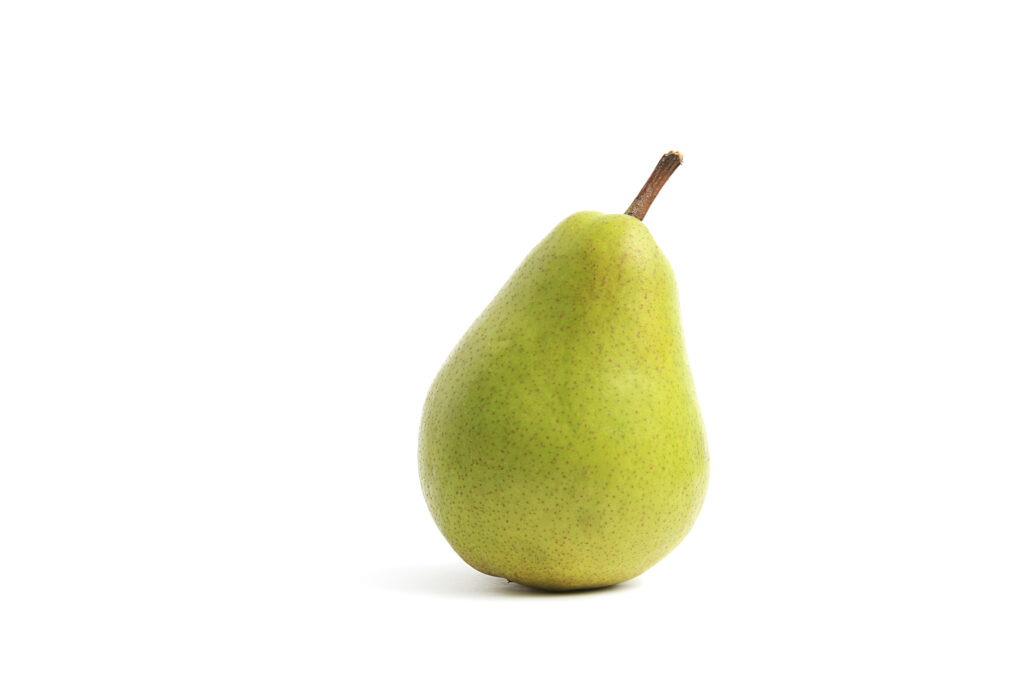
Pears have a Nutrivore Score of 145, making them a low nutrient-dense food. Plus, they are a low-calorie-density food; the calorie count of pears is 80 calories per cup!
Per serving, pears are an excellent source (20-50% daily value) of polyphenols; and a good source (10-20% daily value) of copper and dietary fiber.
Ditch Diets. Embrace Nutrients. Start with this FREE Guide.
Sign up for the free Nutrivore Newsletter, your weekly, science-backed guide to improving health through nutrient-rich foods — without dieting harder —and get the Beginner’s Guide to Nutrivore delivered straight to your inbox!

Pear Nutrition Facts
One serving of pears is standardized to 1 cup, sliced or about 140 grams (4.9 ounces). A typical small pear (140 grams) is roughly equivalent to 1 serving, while a medium pear (178 grams) is equivalent to a little more than 1 1/4 servings and a large pear (230 grams) corresponds to a little less than 1 2/3 servings of pear.
Pear Nutrition Facts Per Serving
| Pear, raw | Nutrivore Score: 145 | Nutrient Density: Low |
|---|---|---|
| Serving Size: 1 cup, sliced (140 grams) | Protein: 0.5 grams | Net Carbohydrates: 17.0 grams |
| Calories: 80 | Total Fat: 0.2 grams | Dietary Fiber: 4.3 grams |
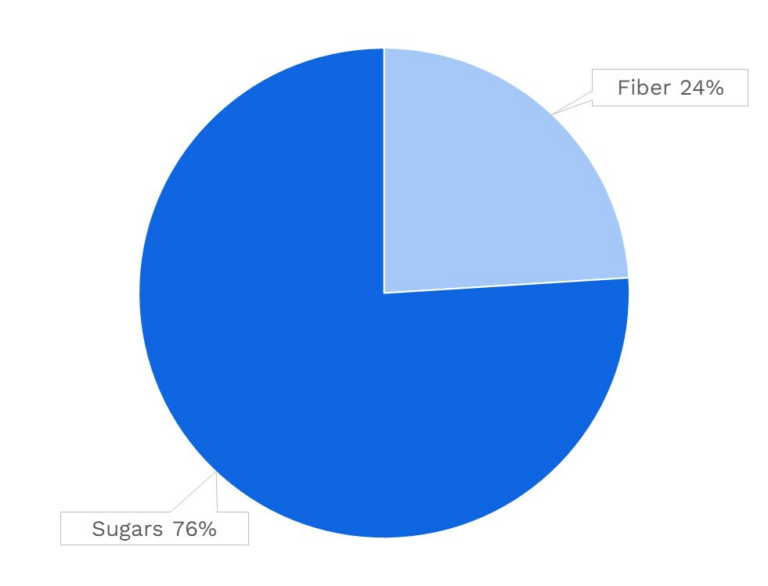
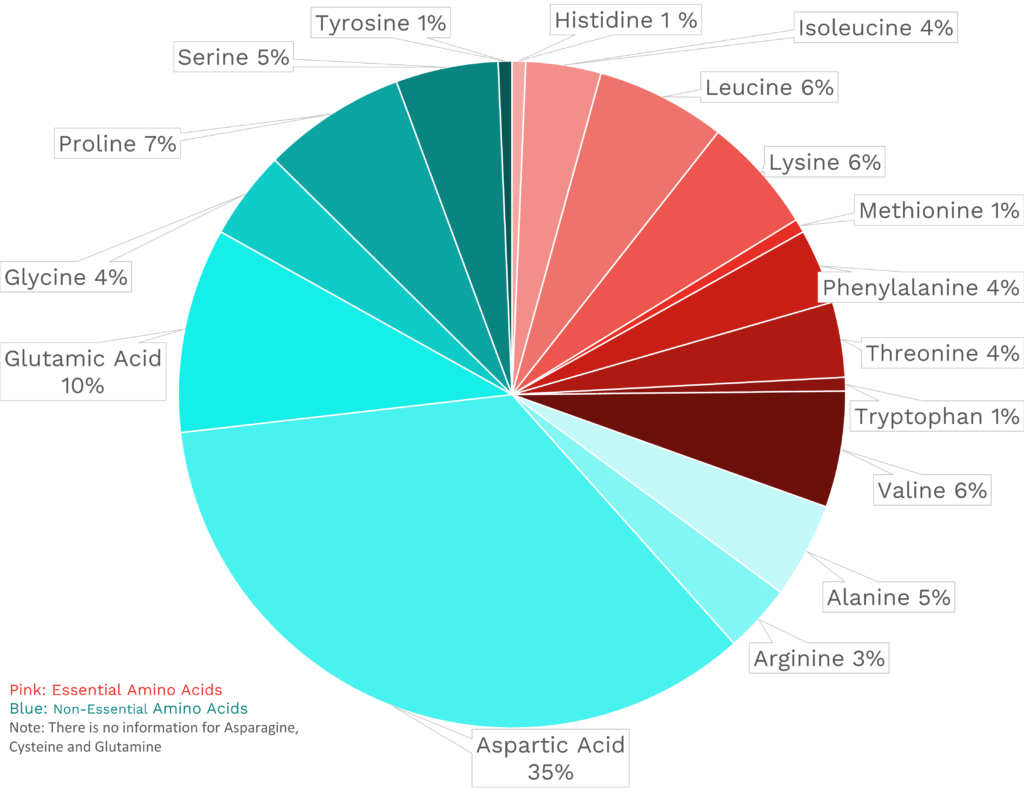
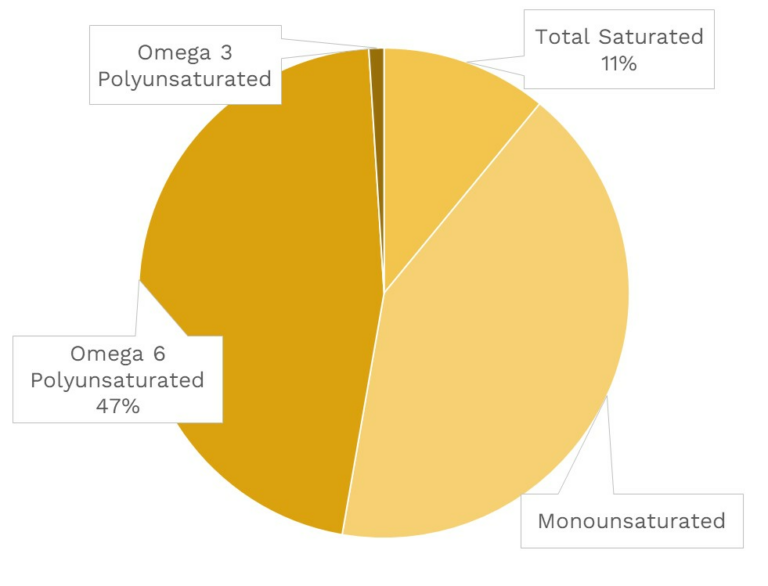
| VITAMINS | ||
|---|---|---|
| Vitamin A | 1.4 μg RAE | 0% DV |
| Vitamin B1 (Thiamin) | 16.8 μg | 1% DV |
| Vitamin B2 (Riboflavin) | 36.4 μg | 3% DV |
| Vitamin B3 (Niacin) | 0.2 mg | 1% DV |
| Vitamin B5 (Pantothenic Acid) | 0.1 mg | 1% DV |
| Vitamin B6 (Pyridoxine) | 40.6 μg | 2% DV |
| Vitamin B7 (Biotin) | 0.4 μg | 1% DV |
| Vitamin B9 (Folate) | 9.8 μg | 2% DV |
| Vitamin B12 (Cobalamin) | 0.0 μg | 0% DV |
| Vitamin C | 6.0 mg | 7% DV |
| Vitamin D (D2 + D3) | 0.0 μg | 0% DV |
| Vitamin E | 0.2 mg | 2% DV |
| Vitamin K | 6.2 μg | 5% DV |
| Choline | 7.1 mg | 1% DV |
| Myo-Inositol | 102.2 mg | ~ |
| CoQ10 | ~ | ~ |
| FUNCTIONAL FATS | ||
|---|---|---|
| MUFA | 0.1 g | 1% DV |
| ALA | 1.4 mg | 0% DV |
| EPA + DHA | 0.0 mg | 0% DV |
| CLA | ~ | ~ |
| Linoleic Acid | 0.1 g | 1% DV |
| MCT’s | 0.0 g | ~ |
| MINERALS | ||
|---|---|---|
| Calcium | 12.6 mg | 1% DV |
| Copper | 114.8 μg | 13% DV |
| Iodine | ~ | ~ |
| Iron | 0.3 mg | 1% DV |
| Magnesium | 9.8 mg | 2% DV |
| Manganese | 67.2 μg | 3% DV |
| Phosphorus | 16.8 mg | 1% DV |
| Potassium | 162.4 mg | 3% DV |
| Selenium | 0.1 μg | 0% DV |
| Sodium | 1.4 mg | 0% DV |
| Zinc | 0.1 mg | 1% DV |
| PHYTONUTRIENTS | ||
|---|---|---|
| Carotenoids | 85.4 μg | ~ |
| Polyphenols | 266.1 mg | ~ |
| Phytosterols | 23.0 mg | ~ |
| Glucosinolates | ~ | ~ |
| Thiosulfinates | ~ | ~ |
| Betalains | ~ | ~ |
| AMINO ACIDS & PEPTIDES | ||
|---|---|---|
| Taurine | ~ | ~ |
| Ergothioneine | ~ | ~ |

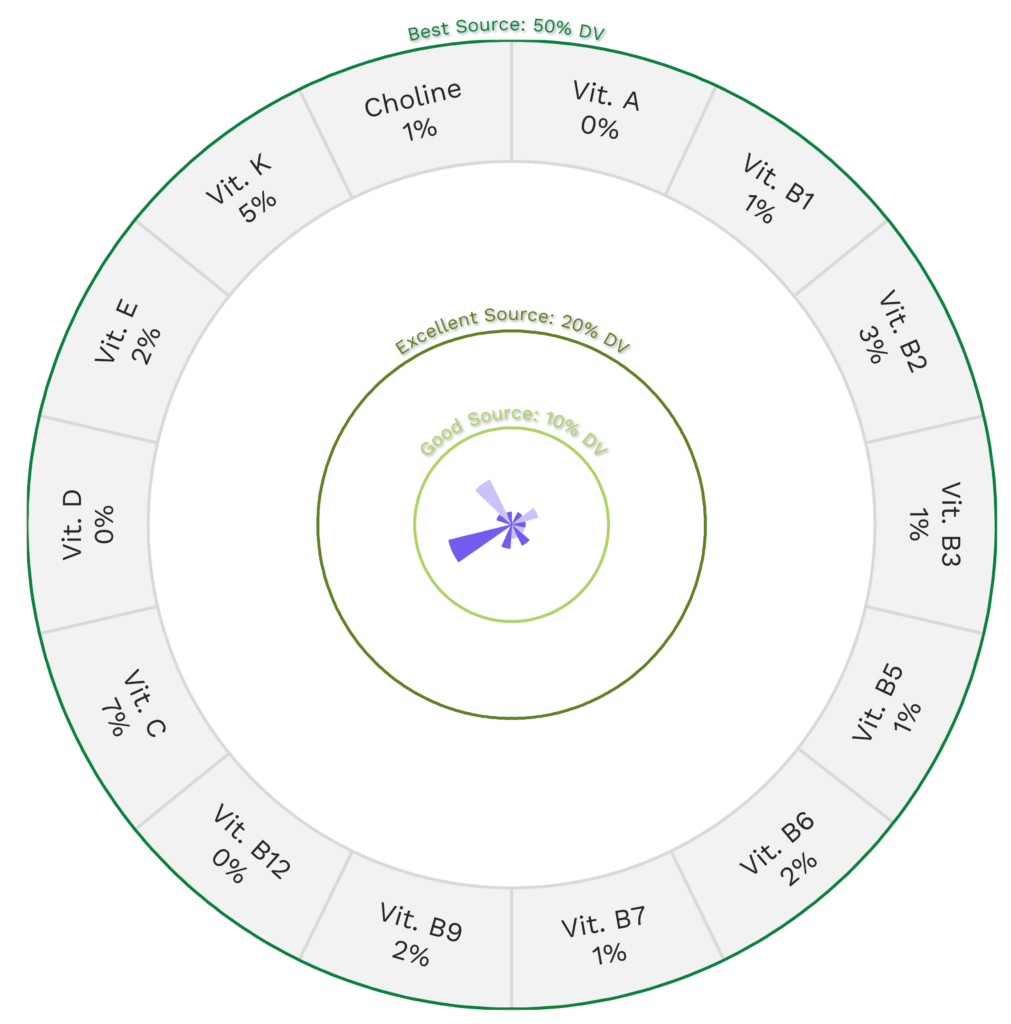
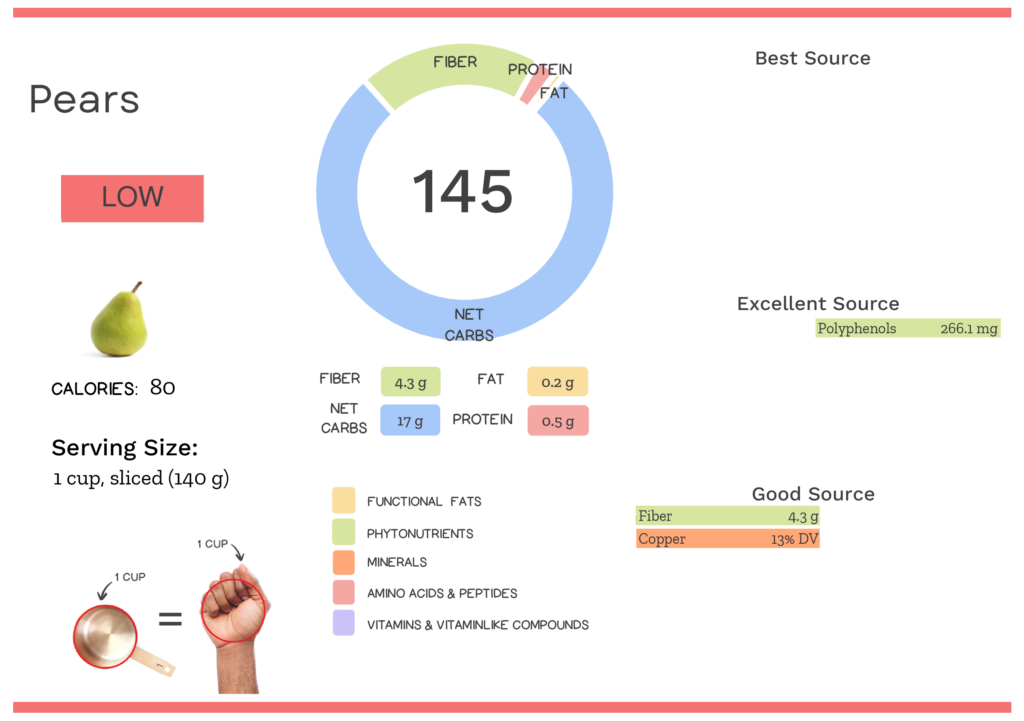
Pear Nutrition Varies With Processing
The Nutrivore Score of pears varies based on how they have been processed. For instance, canned and dried pears are conveniently available year-round, but it’s important to remember that studies show polyphenols and fiber are concentrated in the skin so we benefit most from eating pears unpeeled.
| NUTRIVORE SCORE | |
|---|---|
| Pears, canned, water pack, solids and liquids | 138 |
| Pears, dried, sulfured, stewed, without added sugar | 761 |
| Pears, dried, sulfured, uncooked | 721 |
| Pears, raw | 145 |
Pear Nutrition Varies With Variety
There are over 3,000 varieties of pears world-wide, ranging in color, flavor, shape, size, and nutrient profile which means their Nutrivore Scores vary as well. While only about 100 types are grown commercially and just 3 species account for those widely available for mass consumption, we benefit most from including different varieties in our diet, so it’s worth trying new types if you have the chance!
| NUTRIVORE SCORE | |
|---|---|
| Asian pears, raw | 621 |
| Bartlett pears, raw | 132 |
| Bosc pears, raw | 147 |
| Green anjou pears, raw | 125 |
| Pears, raw | 145 |
| Red anjou pears, raw | 135 |
Did you enjoy “pear-taking” in this info? Maybe your friends will too!
Health Benefits of Pear Nutrients
Let’s take a closer look at all of the best and excellent source of nutrients found in a 1-cup serving of pear and see how they benefit our health.
Pears Provide 266.1 mg of Polyphenols
Pears are an excellent source of polyphenols, providing 266.1 mg of polyphenols per 1-cup serving!
Since so much of the polyphenol content of pears is concentrated in the skin, it’s important to eat pears unpeeled—and also to consume them whole, rather than juiced!
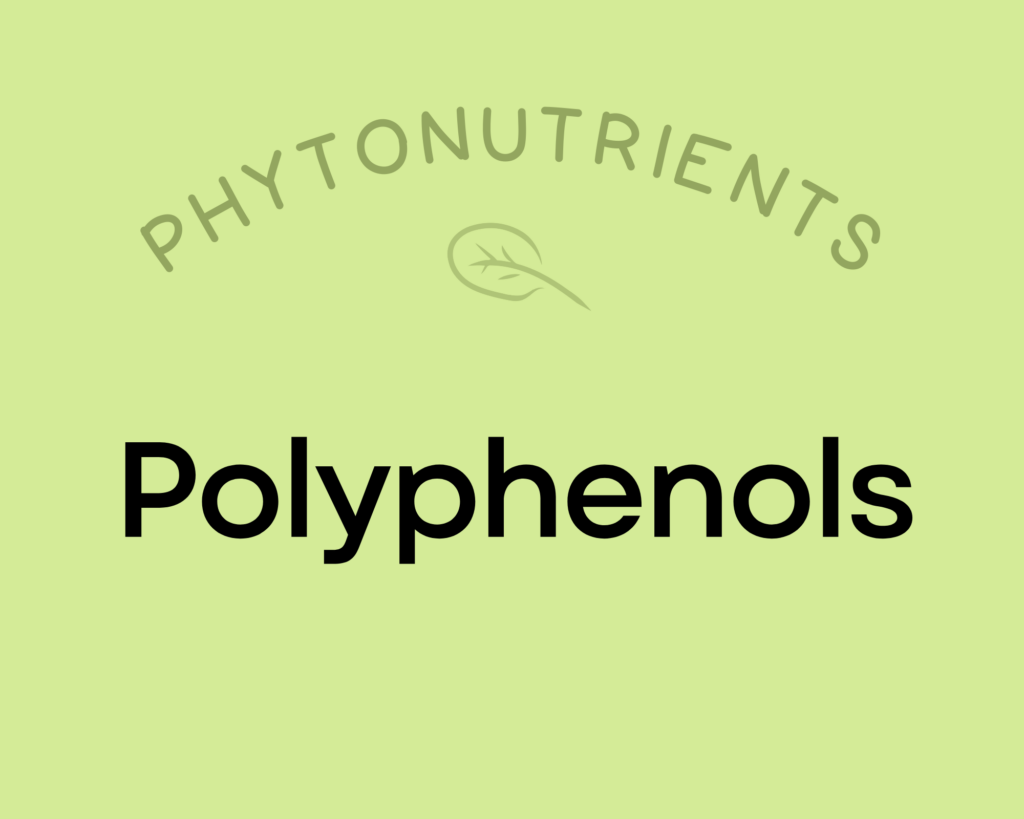
Polyphenols play a huge role in protecting against cancer, heart disease, diabetes, asthma, osteoporosis, neurodegenerative diseases, and other conditions associated with oxidative stress. In fact, a major reason foods like red wine and olive oil (as well as diets rich in both, such as the Mediterranean diet) show up as so beneficial may be due to their high polyphenol content! Along with chronic diseases, supplementing with polyphenols has been shown to protect against infections and reduce the signs of aging. Polyphenols exert their most potent effects by acting as antioxidants—preventing cellular damage by neutralizing hazardous oxygen radicals and improving cellular health as a result (which, in turn, benefits virtually every system in the body). As a result of their antioxidant properties, polyphenols also boost the immune system and protect against both chronic and acute diseases. In addition, polyphenols can help regulate enzyme function, stimulate cell receptors, modulate the functions of inflammatory cells (including T and B lymphocytes, macrophages, platelets, and natural killer cells), alter adhesion molecule expression, affect nerve cells and cardiac muscle cells, and exert antiviral effects. Learn more about polyphenols here.
Learn What Foods Are the Best Sources of Every Nutrient

The Top 25 Foods for Every Nutrient
The Top 25 Foods for Every Nutrient e-book is a well-organized, easy-to-use, grocery store-friendly guide to help you choose foods that fit your needs of 43 important nutrients while creating a balanced nutrient-dense diet.
Get two “Top 25” food lists for each nutrient, plus you’ll find RDA charts for everyone, informative visuals, fun facts, serving sizes and the 58 foods that are Nutrient Super Stars!
Buy now for instant digital access.
How Much Pear Should We Eat Per Day?
Even though pome fruits (aka members of the apple family) aren’t particularly nutrient-dense, they ap-pear-antly still deliver impressive health benefits! How pear-fect! (Hyuck)
Eating two or three servings of fruit per day is optimal from a health perspective. A 2017 systemic review and meta-analysis looked at how all-cause mortality was impacted by varying intakes of 12 different food groups: whole grains and cereals, refined grains and cereals, vegetables, fruits, nuts, legumes, eggs, dairy products, fish, red meat, processed meat, and sugar-sweetened beverages. This analysis revealed non-linear relationships between how much of a particular food group we eat and how it impacts our health. While the results revealed no upper limit to the benefits of vegetable intake, the sweet spot for fruit intake was 300 grams daily. Intakes of fruit over 400 grams per day were not as beneficial as 300 grams, but the good news is that even intakes of 600 grams of fruits per day was superior to no fruit at all! This sweet spot for fruit intake translates to 2 to 3 servings of fruit daily.
And a 2018 review similarly concluded that two to three servings of fruit daily was optimal for reducing risk of cardiovascular disease, type 2 diabetes, obesity, chronic obstructive pulmonary disease, chronic constipation, and inflammatory bowel disease.
Fruit makes a convenient snack, a healthy dessert, a whimsical addition to salads, and a sophisticated flavoring agent in the form of salsas, jams, and chutneys. A serving is standardized to 1 cup chopped for raw vegetables and fruits (typically translates to 1/2 cup to 2/3 cup once cooked). Learn more in Importance of Vegetables and Fruit
Animal studies suggest that pears could help protect against ulcers, regulate alcohol metabolism, and reduce blood lipids.
Observational studies have shown that apple or pear consumption significantly lowers the risk of cardiovascular disease mortality, stroke, type 2 diabetes, and all-cause mortality, while animal studies suggest that pears could help protect against ulcers, regulate alcohol metabolism, and reduce blood lipids.
It’s always best to mix up the fruit and veggies you eat day to day (aiming for a wide variety of different vegetables and fruits throughout the week), and pears definitely have a place at the table.
Easily track your servings of Nutrivore Foundational Foods!

The Nutrivore Weekly Serving Matrix
The Nutrivore Weekly Serving Matrix digital resource is an easy-to-use and flexible weekly checklist designed to help you maximize nutrient-density and meet serving suggestions of Nutrivore foundational foods, all without having to weigh or measure your foods!
Includes a 22-page instructional guide and downloadable interactive guides.
Buy now for instant digital access.
cITATIONS
Expand to see all scientific references for this article.
Clements RS Jr, Darnell B. Myo-inositol content of common foods: development of a high-myo-inositol diet. Am J Clin Nutr. 1980 Sep;33(9):1954-67. doi: 10.1093/ajcn/33.9.1954. PMID: 7416064.
Han JH, Yang YX, Feng MY. Contents of phytosterols in vegetables and fruits commonly consumed in China. Biomed Environ Sci. 2008 Dec;21(6):449-53. doi: 10.1016/S0895-3988(09)60001-5. PMID: 19263798.
Phenol-Explorer: Pear, whole
USDA Food Central Database: Pears, raw
Watanabe T, Kioka M, Fukushima A, Morimoto M, Sawamura H. Biotin content table of select foods and biotin intake in Japanese. Int J Anal Bio-Sci. 2014. Vol 2(4):109-125.


